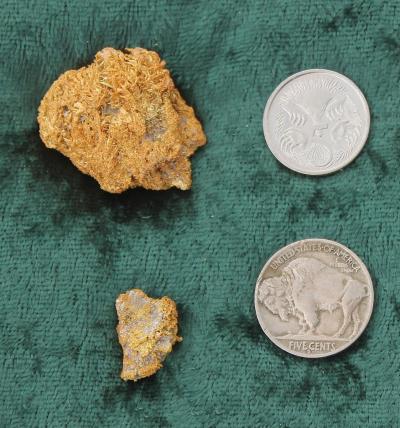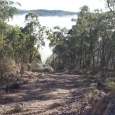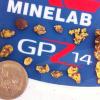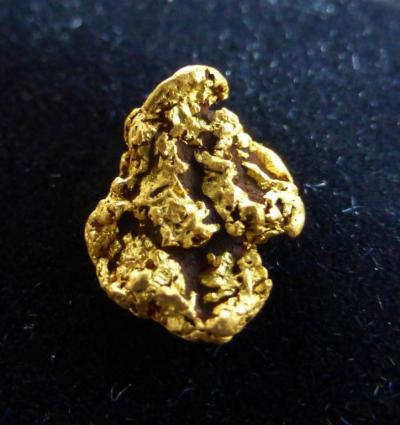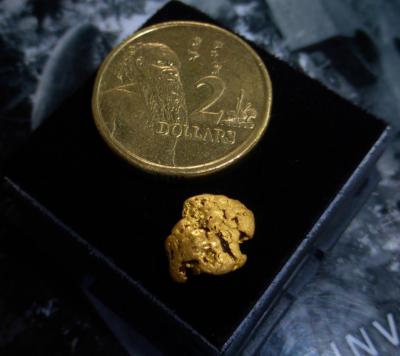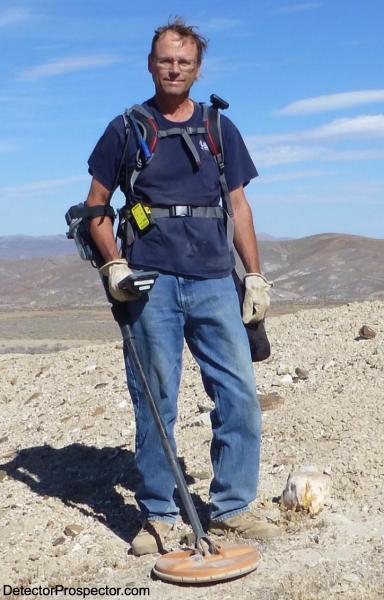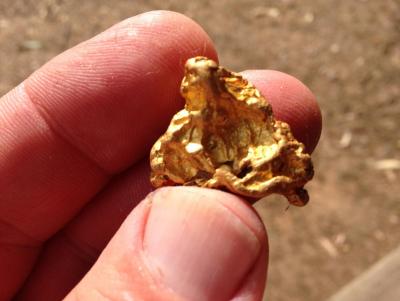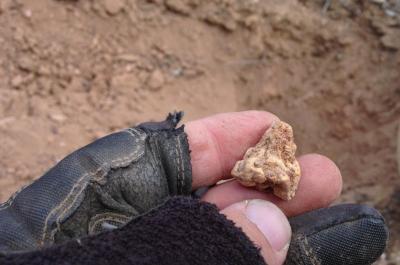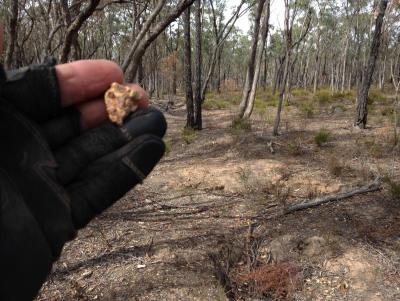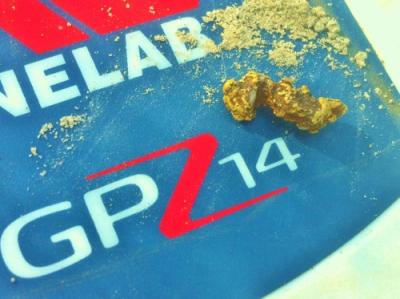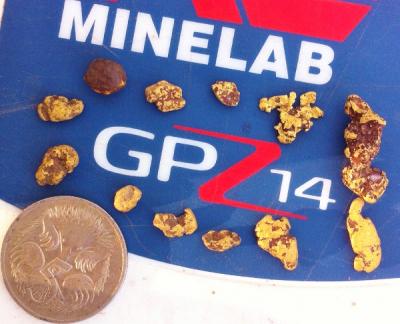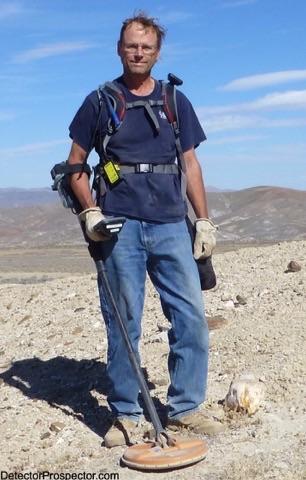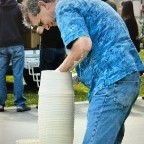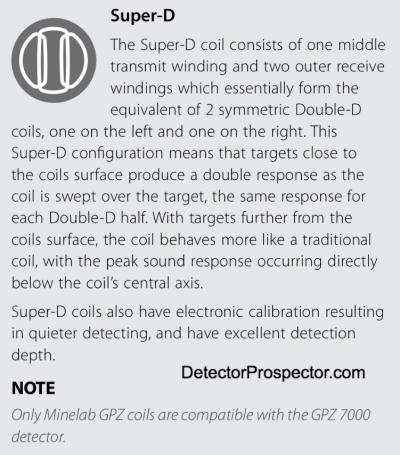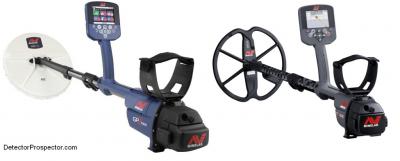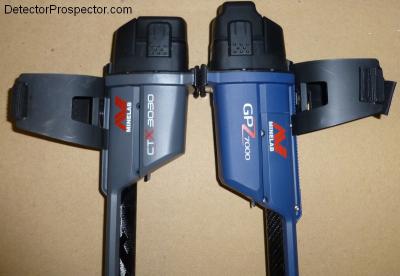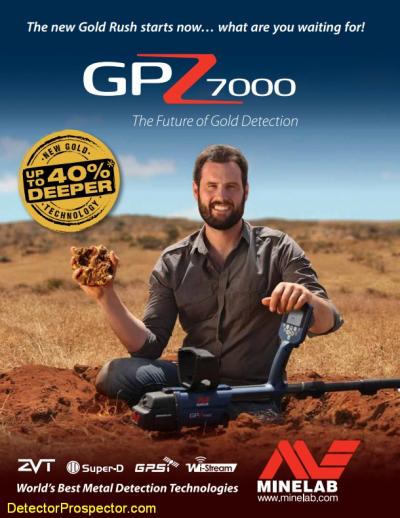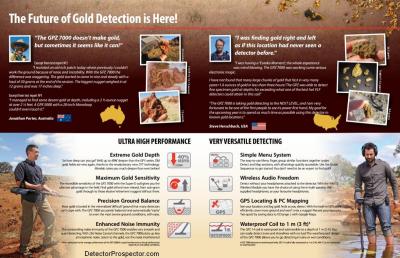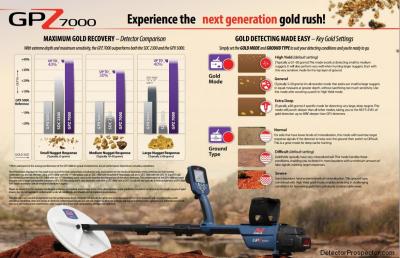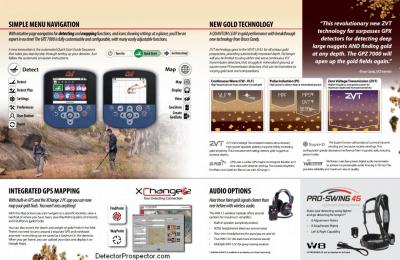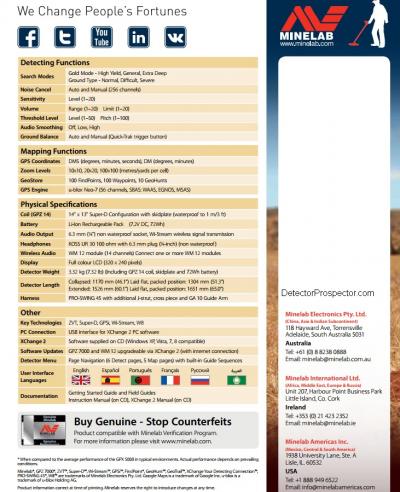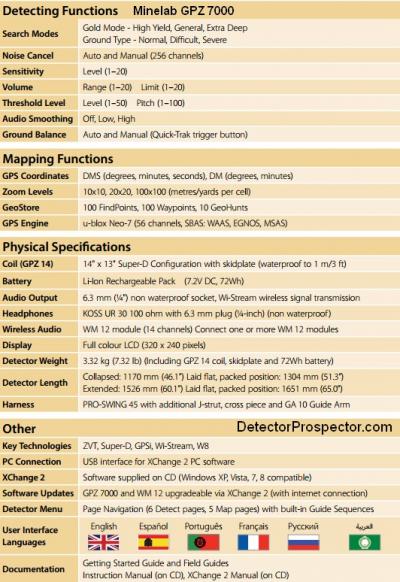Search the Community
Showing results for tags 'minelab gpz 7000'.
-
So I was out in the goldfields of California yesterday with Steve Herschbach and another friend who is a detector dealer. We did some quick tests comparing the 5000 and the GPZ on mossy, wiry gold that we had found previously. These were pieces from both Nevada and California. The smaller of the two nuggets shown in the attached photo weighs 3 grams and with an 11 inch mono set on maximum gain of 20, it was totally invisible to the 5000 - even when it was touching the coil. The detector made no response whatsoever. The GPZ on the other hand could see it at about 10 inches, and it was dug from a pounded patch that has seen many GPX detectors (including mine) at a depth of about 6 inches. The GPZ was set for difficult soil at only 12 sensitivity. So what is the performance improvement over the 5000 when one detector is blind to the piece and the other sees it at 10 inches? Mathematically speaking, it is an infinite improvement - a whole lot more than 40%. The larger of the two pieces pictured in this post weighs 18 grams and the 5000 could see it to a maximum of about 10 inches. The GPZ could see it at 20 inches, and it was dug with the GPZ at about 18 inches. Going from 10 inches to 20 inches is a 100% improvement - double the depth of detection and also a lot more than 40%. We also tested some specimen gold Steve had with similar results - the 5000 could not see the smaller specimens of a few grams size. Of course we all know that the 5000 performs very well with more solid nuggets and specimens. I have found lots of gold with my 5000, it is an excellent detector. However, the GPZ is a gigantic improvement over the 5000 when it comes to mossy, wiry, prickly, specimen and other similar forms of gold. Some may say there is not much of this type of gold out there. I would say in response, if most of us are using detectors that perform poorly on that type of gold, how does the fact that we don't find much prove that it doesn't exist? Truth is that there is loads of specimen gold out there and I think the GPZ will be finding a lot of it in the coming weeks and months. Geologically, many of the places where the nugget gold is truly deep are locations where the patch is sitting as a residual over a vein, and having a detector optimized for specimen gold would make very good sense. Some hard rock deposits tend to produce this type of gold. Smart prospectors with GPZ detectors will be using this knowledge to their best advantage. For me, I have been doing research to find places which produce this type of gold and I intend to be using the coming months to leverage this performance increase to the greatest extent.
-
I realize the discussion on pricing is beyond old, but since I reside in Canada in the summer I thought I'd check out pricing there. $9999.00 Canadian. Current exchange rate now is about $1.00US=$1.25CAN after fees. So if you bought in Alberta where the only sales tax is 5% federal GST and threw in the exchange rate you'd be paying about $8400 US out the door. Of course, if you only have $Can you still are paying $9999.00. ;-)
-
Hi Steve, guy's I would just like to share some idea's of software up dates that minelab could easily make and either sell or supply to improve the GPZ. If minlab is listening I would not mind paying for updates that improve the detector's performance or usability and I'm sure many others would like to be able to purchase updates on an on going basis and that minelab could have an on going income stream without any manufacturing costs only software development costs and by listerning to us the customers and tailoring updates to suit our needs\wants. We the customer would benefit by getting a better detector without having to fork out for a whole new platform. Win win if you ask me! Any way here are a few ideas of mine for changes that I think would improve the Zed and make it even better. I hope minelab is listerning! 1_ I would like more control over the audio settings like on the 5000, I was very disappointed when I picked up the zed and read the manual and realized that I didn't have the control that I had on the 5000. So I would like full numerical 1_20 control of the stabilizer like on the 5000. I would also like to have the audio type setting back as being able to change the audio curve to suit my circumstances and fine tune with the stabilizer, motion and target volume controls. 2_ I would like to have 10 user modes that I can assighn names and program both on the detector and via exchange so I can set up 10 different groups of settings for different circumstances, like on the ctx with the user modes. And I would like to be able to assighn the modes to my user button so i can toggle between one user mode(groupe of settings) and the one one originally seleted. 3_ Full control of the settings in the excange2 software most notably the assighn user button function. I think that the way the timings are setup now is an improvement over the 5k. As once you understand what they (Gold type and Ground type) do minelab have given us more control over the front and back of the timings and we can now independently optimize for the target size and ground conditions so it is definatly a step in the right direction. Any way thats my thoughts for now I would like to hear what you guys think, and hear any other ideas you guys might have. Regards Dale
-
Was wondering if anyone had any technical info on the GPZ7000. Read on an Aussie forum that the ZVT technology is in fact Pulse Induction. It is my belief from what I have read elsewhere & what Minelab are saying that it isn't Pulse Induction but a completely new, standalone technology at it's early stages with more improvement to come? Does anyone know if ZVT is technically a variation of Pulse Induction or in fact totally new? Also the audio output of the GPZ7000 - in the same thread it is suggested "listening to the sounds of targets being located makes it obvious that the GPZ is basically a PI detector". It was my belief that detector tones can be set by the technician over a range of "sounds" & that Minelab set theirs at the distinctive warble/tone of previous machines. The sound wouldn't have anything to do with the "type" of detection technology used? Or does it? Anyhow it doesn't really concern me either way but I am watching with interest how things unfold now it's getting out there with more users. A very interesting machine but the SDC will have to do me for now.
-
Now we know why you have been absent - busy you are! And Happy Birthday My Friend!
-
Back down here in Australia I'm reading and hearing a lot of negatives on the GPZ 7000. I don't mind at all because I'm just going out and finding these with mine I will admit however there is much to learn. ad...
-
This is my attempt to explain my own personal opinion of the GPZ 7000 based on what I know so far. The very real problem is I do not know everything and in fact still consider myself a novice with the detector. I have a lot to learn yet, so those thinking I know everything and can answer everything definitively are going to be disappointed. Some things I flat out do not know, other things all I can do is offer a qualified guess. What I can promise is I am not out to talk anyone into getting one. Not my job. I did not get my GPZ 7000 for free although I did get a great deal on it. Despite what people may think being a field tester does not obligate me to post about the GPZ 7000 and it certainly does not make me a salesperson. I am however more than happy to offer my opinion for those that are interested. Here goes with where I am right this minute 2/18/2015. I am fortunate to have had the opportunity to field test the new Minelab GPZ 7000 detector. It has allowed me time to make decisions regarding my own use of detectors this season earlier than most people. It also gave me a place first in line and I now have a brand new GPZ 7000 of my own. My use of the GPZ 7000 combined with what I think I know about how it works made me decide I had to have one. I am in my detecting prime right now and plan on spending a huge amount of time swinging a detector looking for gold now and in the future. I will never use just one detector for everything but the fact is that I can only swing one detector at a time. I need to decide what detector will be my primary unit for the bulk of my detecting. What one machine will best return my investment of time and effort in possible gold finds? I have decided that machine is the Minelab GPZ 7000. The GPZ with its 14" x 13" Super D coil provides an across the board powerful solution for getting gold both large and small on the first pass. Most ground I pass a coil over I have exactly one chance of finding a target. It has to happen on that first pass. Sure, when I am beating a patch to death I may hit the same area over and over. But most of my detecting is all about being over ground I have never been over before. I have to have confidence the machine I am using is going to give me my best shot at getting whatever is there on the first and likely last pass of the coil. As far as I am concerned all the percentages and charts and stuff is something others can debate, though I will post some thoughts on that separately. The bottom line is I am convinced the GPZ 7000 does give me a technological edge at this time, and that by applying that edge early and as often as I can I am increasing my odds of finding gold. If I never said another word about the detector that really just sums it up. I thought very hard about whether I should keep my GPX 5000. I decided any time spent with it would detract from the advantage I would enjoy by using the GPZ instead. It should not have been lost on people that I recently sold my GPX 5000 and almost every accessory I owned for it. I only have a few odds and ends left I intend to sell soon. That alone should tell you everything you need to know about what I think of the GPZ 7000. I even considered selling my SDC 2300. However, even though more coils will be available soon for now all the GPZ has is the 14" x 13" so I decided I had better keep the SDC just because it has an 8" coil. The reality is I very much like the grab and go super compact nature of the SDC and will probably keep it anyway, but it is a moot point until a smaller coil becomes available for the GPZ. Small coils are a must for nooks and crannies and other places larger coils can't fit. The GPZ 7000 does not replace or take away from the SDC 2300 and GPX 5000 in the current Minelab lineup. They are both fantastic units. The GPX 5000 and its vast ecosystem of coils and other accessories remains the no-brainer best value for many people. The SDC 2300 will continue to be the hot small gold sniper it has been proven to be. A person who owns both will have much of the power of the GPZ 7000 already at their disposal. The thing is the GPZ 7000 to the best of my determination so far seems to offer everything those two models offers in a single unit, and then goes farther yet. I can't swear that under every circumstance and in every scenario that the GPZ 7000 trumps the SDC 2300 or GPX 5000. Certainly in the case of the GPX 5000 all those accessory coil options do matter, especially where ground coverage is job one. The SDC does have that little coil. All I can say is that for that proverbial one pass over any particular chunk of ground I have to pick the GPZ 7000 as my best bet for getting whatever gold is there or missing it forever. And for hitting already hunted ground it is going to find gold both those detectors will miss no matter how many times they pass over the ground. The GPZ 7000 in my opinion is the best overall single solution available. If I was told I had to sell all but one machine and could only use one detector for gold prospecting I would without hesitation choose the GPZ 7000. In closing, I suddenly see a bright future ahead. I really had given up on there being anything significantly better than a GPX 5000. The GPZ however is not the end of the road but just the beginning. As good as it is it is not perfect and I am certain we will see further improvements as the platform is refined in the future. That first step is often the biggest however, and the GPZ in its way is every bit the breakthrough the SD 2000 was when it was released. Nobody can put back all the gold that has been detected in the twenty years since but the GPZ 7000 is definitely the next step in getting what is left. My thanks to Minelab for being able to say I had a part in this, small as it has been. Thanks especially for investing the huge amount of dollars and people power it took to make this happen for us, the prospectors of the world. Were it not for Minelab electronic prospecting would not be near what it is today. Disclaimer - this is just me trying to explain my thought process regarding my use of detectors this season. It is not an attempt to say "here is what I am doing and you should do it also." Just because I am all in with the GPZ 7000 does not mean I am saying that is the best idea for everyone. It is all about prospecting skills, not about the detector you use. The GPZ 7000 will not turn a poor prospector into a good one. It lacks that magic button. At the end of the day it is just another metal detector and it is up to the prospector behind the handle to make it deliver. Good Luck!
-
Below is a picture of a nice 30 gram piece I found in Victoria during recent field trials..... I only have a basic working knowledge of patches and locations down there so was pretty happy when I plucked this chunk out of a patch I took a crew of Minelab guys to a few years ago on a training session with the GPX 5000, I can assure you all of us had our coils over it at one time or another because it was right in the guts of the main run. Gold mode and Ground Type was General/Difficult, Sensitivity on 12 and Audio Smoothing at OFF. These are the best settings for large deep gold (1 oz+) in the noisy ground in Victoria's Golden Triangle. JP 30 gram slug at a depth of 16" under an old boys throw out heap
-
Hi folks Went back to where I detected a gram nugget with my Zed beast the other day. Even though we here in Australia are now officially in autumn it was stinking hot out there 40 odd degrees ( 104 °F ) Slogged it out for the day for 6.5 grams. ad...
-
Anyone that knows the history of gold rushes knows they are very limited in duration. To clarify, I mean gold rushes as occur on the scale of the individual prospector. A person working more or less on their own with limited means. In a classic gold rush a new discovery is made, and the prospectors "rush" to the area. Typically there are very high amounts of gold found early on as easy pickings are plentiful. Unfortunately the easy pickings are soon gone, and the prospectors wait until a new discovery is made. They once again rush to the new area, and the cycle repeats. Some gold rushes are purely economic. A quiet gold rush occurred during the Great Depression not because new gold locations were found, but because people were desperate to find income of any sort wherever it could be found. The gold rush in the 1980s was a result of skyrocketing gold prices. Another way a gold rush occurs is when new technology takes hold. The development of the light weight portable suction dredge created a small gold rush as prospectors took to the hills with this ability to work underwater in streams and rivers. We are in the latter days of the electronic gold rush. It really took off in the 1980s in Australia with the development of decent VLF detectors capable of finding gold nuggets. The VLF Gold Rush. The easy surface gold depleted, but then a second wave developed with the introduction of the Minelab PI detectors in the 1990s. The Minelab PI Rush has largely run its course. It really has only been kept alive by steadily increasing gold prices as the gold finds themselves dropped off. We can find half as much gold at $1200 as we did at $600 and still pay for beans and fuel. Gold prices have been weakening however, and the technology itself reached a dead end five years ago. I have seen the end coming for some time. It is not just gold prices and the technology but increasing regulation and ever more difficult access issues. The entire Electronic Gold Rush has taken place in my adult lifetime and I am likely to see the day when there are only a few diehards left at it. The good news is in my opinion we are on the eve of what may possibly be the last gasp, the last breath of fresh air. The GPZ 7000 really is a new twist on electronic prospecting that promises to give prospectors what it ultimately takes to fuel any gold rush. Hope. We have to have new hope, a new reason to believe once again we can go out and make worthwhile finds. The GPZ will succeed simply by getting everyone to hit everything one last time, as hard as it can be hit. There is not one bit of ground I have ever detected that I would not give another go one more time, just because I have a GPZ 7000. That means I and others will find gold that until now has gone missing. People will point out that other detectors may well have found some of the gold. That it simply got missed before and now the GPZ found it. They will in many cases be correct, but in the end I think they are missing the point. It is that renewed hope, that renewed faith that really matters, as once again prospectors hit the field in numbers with what they perceive as being the latest and greatest. And when it comes to gold rushes, perception is very much reality. I am just thankful I was born when I was. Sometimes I think I should have been born in the 1800s, but the fact is I enjoy all the things modern life offers me. Instead, I got to participate in the 1980s Gold Rush in all its glory, both as a prospector and as a guy selling the shovels to the prospectors. Now, semi retired and living the dream as a full time prospector I have a chance to participate in what may very well be the last chapter of the electronic gold rush - The GPZ Gold Rush. I have to admit I am very happy to be in the right place and time to get in on the ground floor of one last party! Exciting times my friends. Good luck to each and every one of you now and in the future days ahead.
-
I would be curious if anyone has used the GPZ on salt water beaches and if they think it has any advantage over other PIs in this environment.
-
My Gpz came late yesterday (Saturday), by the friends at FedX. I'm glad it came unassembled, because it gave me a chance to appreciate the individual quality and fit of each component. Everything is nice quality as I would expect for the money, even though the detector is a bit heavy, judging by the individual parts and the materials used in construction it's as light as possible with existing technology I'd guess. Fit and finish is in a different ballpark than my Whites as was the cost. Assembly was easy, my only question is it best to use only one strut on the harness on your dominate side, or just put struts on both left and right (they sent two but only show using one)? I found the harness comfortable and with the harness the detector weight was a nonissue. Gave the batteries a full charge, powered up and completed the setup and audio sync... Also very simple to do, just follow the on screen prompts, no problems. I have large power lines directly behind my home so the Gpx was a bit unstable and not warmed up. I did not have it on for more than a few minutes, I'll play with the settings after studying the book some more and see if it will handle the interrence from the power lines. Clark
-
I spent some time reading the US public patent document last night and I think I have a very basic idea and perhaps not fully correct of how that coil works now. They use one (or both, the patent isn't clear) of the D's to monitor changes in the TX coil due to varying ground permeability aka mineralization and then use a negative feedback amp to keep the current constant in the TX since the reactance of the coil changes as you move over different ground or targets. So that basically ground noise and effects are nulled out constantly at what the monitor sample rate is. I think that's also where they get the term Zero Voltage Transmission since V = 0 when absolute value of di/dt > 0, but I'm not sure about that and abs(di/dt) > 0 is only true when speaking in terms of averages which they do explain. I can't figure out if I am missing something on understanding the bigger ZVT picture though or if it's kinda a semantics thing? You can see in the provided sample waveforms there is always a non-zero current present which differs from traditional PI designs. The other net effect is that the coil remains in a critically damped state more or less constantly rather than changing as you swing and thus interefering with the decay time and thus the RX sampling period as with a traditional PI - a simple way to think about that is if your coil is still ringing during RX sampling then you have a hard time listening for target responses. It seems like that is where they are able to sample and detect lower conductivity or quick decay rate gold targets maybe? So it's kind of a mono coil but not, and kind of a DD coil but not. Looking at the sample waveforms and their description it looks like a PI in theory still, but kinda not too. Also, there is a point made about programs and updates in that document. Which leads to some interesting speculations about future models...maybe just program updates? No idea at all, just guessing. Am I understanding all this correctly or have I steered awry somewhere? Getting through the patent legalese speak is kinda tough in that document for me.
-
Instead of everyone getting all cranky, waiting for the new GPZ 7000. Let's make the wait more tolerable. Guess the new Price!!! The winner gets??? Well half of nothing. Unless Steve H or anyone has some Minelab swag to sweeten the pot. Closest to the MAP without going over. I guess $ 8450.00.
-
Minelab GPZ 7000 and CTX 3030 The Minelab GPZ 7000 weighs 7.32 lbs and the Minelab CTX 3030 weighs 5.2 lbs. Both are almost perfectly balanced. Where is the weight difference? The Minelab GPZ 14 coil comes complete with lower rod attached. I assume if you buy one new it will also come with a scuff cover like all Minelab coils but I do not know this for sure. A scuff cover does come on the coil when you purchase the GPZ 7000. The coil assembly with scuff cover and lower rod weighs exactly 3.0 lbs as weighed on my digital postal scale. The lower rod assembly with nuts and washers weighs 4.8 ounces. The scuff cover weighs 4.3 ounces. The coil alone without rod and scuff cover is 2 lbs 6.9 oz. Compare this to the stock 11" DD coil on the Minelab CTX 3030 at 1 lb 6.2 oz with scuff cover and you can begin to see why the GPZ 7000 weighs what it does. To get proper balance for that 3 lb coil there has to be offsetting weight behind the handle. Even the 17" coil for the CTX 3030 only weighs 1 lb 15.8 oz. Now lets look at the detector bodies: The GPZ body is obviously longer than the CTX body. The GPZ body with battery weighs 4 lbs 0.3 oz and the CTX body with battery weighs 3 lbs 6.2 oz. The GPZ battery is larger and at 72 Wh has nearly twice the capacity of the 34 Wh CTX battery. The GPZ battery weighs 13.0 oz. versus 9.0 oz for the CTX battery so you are getting twice the power for only 50% more weight. The batteries are interchangeable so you can use your CTX battery as a backup on the GPZ 7000 or buy a GPZ battery to get extra running time on a CTX 3030. The smaller battery and a smaller coil option have the potential to easily shave over a pound off the total weight GPZ 7000. I can imagine say something like a 8" x 11" semi-elliptical coil and the smaller battery making a nice balanced combo. The longer 38" two piece rod from the GPZ 7000 will plug into the CTX 3030 for a gain of 6" over the 32" single piece CTX rod. However, the way the coils mount is totally different though in theory they could be made to work. GPZ 7000 coil and rod plugged onto CTX 3030 14" x 13" GPZ 14 Coil for GPZ 7000 with Lower Rod and Scuff Cover
-
Hi Steve, To start off, you have a great informational site here. I have always liked your posts from around the different forums and now you have it all right here and you are sending out info double time. Very nice. Since this thread has an SDC component to it I would like to ask the question I been wondering about. I have read JP's analysis that he can run GPZ head to head with the SDC except for very small surface gold. I have both a 5000 and SDC and quite honestly I love the stealthy little detector and use it 90% of the time. It just work in the steep manzanita choked hills that I frequent much of the time here in Shasta Co. I would like to get your take on the small/med gold performance difference between these two here in our local soil conditions of Northern Cal and Nevada? Thanks Jeff
-
Here it is, good stuff as always http://www.minelab.com/aus/treasure-talk/introducing-the-gpz-7000 The only major note I will add is that the High Yield/Normal ground combination can be even more effective in our low mineral ground conditions in the US than the High Yield/Difficult ground combination that JP recommends for most Australian ground. Not all ground here tolerates it but where it works it really works.
-
Hi Steve, will the 7000 fit in a large airline approved suitcase...the specs mention a size in the packed position, I am not sure what that means... What I really want to know is how to get this on the plane to Oz when I go again? fred
-
This is it folks - most of your questions answered, and fodder for forum controversy for sure! Official Minelab GPX 7000 Sales Brochure Full pdf Version
-
This is the official Minelab GPZ 7000 Owners Manual 12/2018 updated (4901-0176 Rev 3) https://www.detectorprospector.com/files/file/35-minelab-gpz-7000-user-guide/ And the simple Getting Started Guide https://www.detectorprospector.com/files/file/36-minelab-gpz-7000-getting-started-guide/
-
A lot of people have talked about the coil comparisons in the GPZ video with regards to the larger deeper stuff. What about the fact that the GPZ is being said to go deeper than an SDC on small gold – 14" coil compared to 8" coil. If that's the case I'm impressed. I also hope there will be an 8" coil option in the GPZ's future. Imagine how much better it could do on sub gram nuggets if it had that coil! My question is; Does the GPZ really beat an SDC on small nuggets even with a 14" Coil? Is that number coming from that 5 gram mark or sub grammars too? With the detector reaching buyers this Friday and that one website doing a countdown to Wednesday, I suspect the gag will be lifted off Steve and JP Wednesday as well. Whenever they get to talk, I look forward to hearing their conclusions. I look forward to seeing the gold they've found with it as well!


